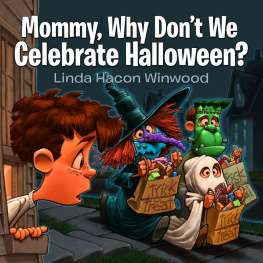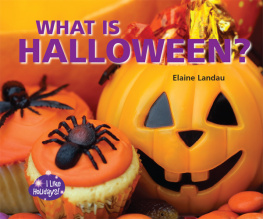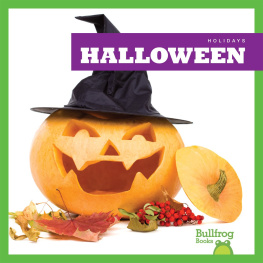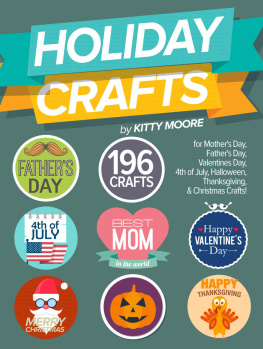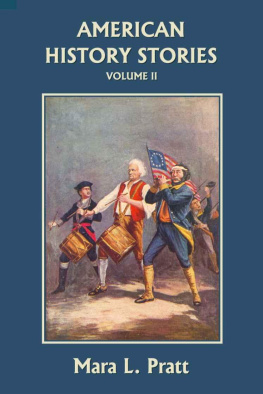Copyright 1990
By Lesley Pratt Bannatyne
All rights reserved
Published by Facts On File, Inc., 1990
Published by arrangement with the author by
Pelican Publishing Company, Inc., 1998
First Pelican edition, August 1998
Second printing, September 2000
Third printing, August 2005
The word Pelican and the depiction of a pelican are trademarks of Pelican Publishing Company, Inc., and are registered in the U.S. Patent and Trademark Office.
No part of this book may be reproduced or utilized in any form or by any means, electronic or mechanical, including photocopying, recording, or by any information storage and retrieval systems, without permission in writing from the publisher.
Library of Congress Cataloging-in-Publication Data
Bannatyne, Lesley Pratt.
Halloween : an American holiday, an American history / Lesley Pratt Bannatyne.1st Pelican ed.
p. cm.
Originally published: New York : Facts on File, 1990.
Includes bibliographical references and index.
ISBN-13: 978-1-56554-346-1 (pbk. : alk. paper); ISBN 9781455605538, ebook
1. HalloweenUnited States. 2. United StatesSocial life and customs. I. Title.
| GT4965.B28 1998 | 98-30160 |
| 394. 2646dc21 | CIP |
Manufactured in Canada
Published by Pelican Publishing Company, Inc.
1000 Burmaster Street, Gretna, Louisiana 70053
For my familyHallowe en, Hallowe en
Strangest sights Ive ever seen,
Witches hat, coal-black cats
Ghosts and gobblins,
Mice and rats.
Author unknown
Introduction
It is Halloween. Grinning under a coal-black cats head made of your mothers tights and pipe-cleaner whiskers, you ring your neighbors doorbell. A porch light switches on and a shadowy figure opens the door. You stand your ground, heart pounding madly, and thrust out a brown paper bag. Trick or treat! The figure shies away in mock horror and returns to pop a chocolate in your bag. You fade back into the night, on to spook another house.
You might remember a similar encounter on Halloween as a child. Those born earlier in this century might remember a parade, or a barn dance with hot apple cider and fresh doughnuts. Our great-grandmothers would have conjured a different affaira party, perhaps, with parlor games and roasted nuts and tubs filled with apples theyd fish for with a fork between their teeth. Earlier still, women might have gathered together in the farmhouse kitchen to ask if witches really do take the shape of bugs and pass through the keyholes of locked rooms...if bats really do eat the souls of the dead...or if you can really hear the devil read from the church steps the names of the ones who will die on Halloween. The history of Halloween in America is the history of American folk; it tells the story of the ethnic, religious and occult heritage of all the peoples who settled here.
You can trace the history of Halloween only if you define the celebration as a grouping of essential elements: communion with the ancestral dead, divination and fire. Witches, cats and bats. Pumpkins, pranks and masks. Costumes, tricks and treats. This is what Halloween is made of, a folk celebration that has endured and evolved from generation to generation.
Halloween begins well over 2,000 years ago in the British Isles. Here, we find the holiday stripped to its most essential element: a night when Celtic tribes communed with the spirits of the ancestral dead. These grand and glorious pagan celebrations were assimilated by the Catholic church after the Romans conquered the lands of the Celts. Rather than extinguish old customs, the church leaders provided Christian versions of them: from the Middle Ages on, All Saints Day and All Souls Day replaced the ancient Celtic celebrations of the dead. These feast days, grouped with the eve of All Saints as Hallowmas, existed in Europe together with old pagan rituals for hundreds of years.
It was a tenuous connection at best that brought the seeds of Halloween to America. Whereas the holiday was once part of the seasonal folk culture of Europe, it was deemed political suicide for the 17th-century English Protestantsthe Puritanswho immigrated to the northeastern part of America. The public celebration of Halloween disappeared in Puritan New England, but some of the holidays folk elements traveled forward a few days in the calendar to a secular holiday, Guy Fawkes Day. Other American regions retained the celebration of All Saints Day, and men and women in every colony acknowledged the occult elements associated with the holiday.
After the American Revolution, entertainments called play parties grew popular in the new, democratic nation. These were nondenominational public events that usually took place in local schoolhouses or town buildings rather than churches. People clapped and shouted, played games and told stories well into the night. The play party held in the late autumn was a precursor to American Halloweenthere were apples and nuts aplenty, plus divination and dancing designed to encourage a little romance before the onslaught of a solitary rural winter.
But Halloween was still not a uniform, annual national celebration, like Thanksgiving or the Fourth of July, and its celebrations varied depending on the ethnic or regional heritage of its participants. Southern girls might look down a well to spy the face of their future husbands, while girls in Chicago wrapped eggs in string and watched them burn in the fire. Halloween in the Northeast might have been a toasty gathering around a fire with celebrants eating nuts and telling stories; in the Ozarks, Halloween might have been a barn dance and a grinning contest.
A real synthesis of Halloween customs did not take place until the mid-19th century, when famine in Ireland drove many thousands to America to find new homes. The Irish had precious little to pack with them in the way of wealth or belongings, but they did manage to bring along their old-world October 31st celebration. Wherever the Irish wentBoston, New York, Baltimore, through the Midwest to Chicago and beyondHalloween followed along. Irish Halloween rituals met with similar rituals practiced by blacks, Germans, English and Scots and gained momentum throughout the second half of the 19th century.
By the turn of the century, Halloween became a full-blown American holiday. The Victorians, always anxious to unearth quaint and historical entertainments, printed Halloween divination rituals in periodicals that finally reached a nationwide audience. Although the holiday was somewhat doctored to suit a Victorian readership, Halloween at last made its proper debut in American society.




